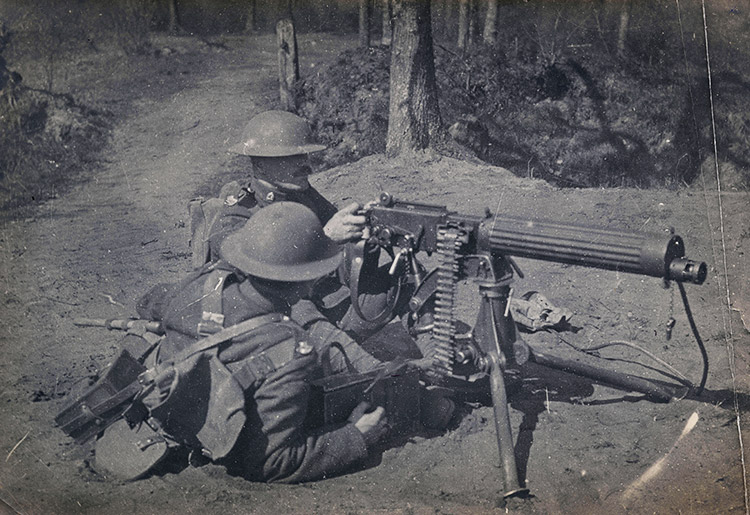Depending upon the gunner and conditions, a barrel change could be needed as typically as every 200 to 250 rounds. When the hot barrel was eliminated, it was set aside till it was cool enough to utilize again. Machine-gun teams would have as lots of as 6 spare barrels on hand.
Driving through a recently protected location in Belgium, the sharp-eyed Liniewski identified the deserted weapon in a field. Liniewski then did what any unsupervised GI would have done in that position; he stopped his truck and took the opportunity to snag a great keepsake for the folks back house. As a support soldier, Liniewski was not familiar enough with weapons to dismantle his MG-42, so he hung on to it for a while until he discovered a camp where German prisoners of war were being held.
The weapon remained in the Liniewski family till 2016 when his kid Marty donated the weapon to the Museum. In spite of its propensity to overheat, the MG-42 was an exceptional weapon that was light-years of ahead of the United States counterpart, the Browning M-1919A4 maker gun. Germany produced approximately 400,000 MG-42s during the war, a few of which are still in active duty.

Taken together, all these weapons offered the Red Army a more useful series of assistance weapons, much better able to challenge the Germans for fire supremacy on the battlefield. Totally illustrated, this study describes the innovation and the tactics of these gatling gun. Noted authority Chris Mc, Nab sets out how these maker guns were dispersed and tactically applied and provides many examples of the weapons in action, from assault groups on the streets of Stalingrad to tank crews having a hard time for survival at Kursk.
Arms Of The First World War Things To Know Before You Get This
Illustrated with top quality photos and specifically commissioned art work, this is a deep analysis of these necessary tools of warfare within the Soviet forces.
Taken together, all these weapons offered the Red Army a more practical variety of assistance weapons, better able to challenge the Germans for fire superiority on the battlefield. Completely detailed, this research study discusses the innovation and the techniques of these gatling gun. Kept in mind authority Chris Mc, Nab sets out how these gatling gun were dispersed and tactically used and supplies various examples of the weapons in action, from attack teams on the streets of Stalingrad to tank teams struggling for survival at Kursk.
Illustrated with top quality photographs and specifically commissioned artwork, this is a deep analysis of these necessary tools of warfare within the Soviet forces.
The gatling gun company, commanded by a captain, had an assigned strength of 6 commissioned officers and 172 employed men, and carried 16 weapons, four of which were spares. Within the company there were three squads and a head office area. A first lieutenant led the very first army, while 2nd lieutenants led armies 2 and three.
Unknown Facts About American Machine Gun Battalions In World War I

Within each section were 2 weapon teams, each with one weapon and 9 men, led by corporals. The gun squad had one battle cart, pulled by a mule, to transfer its weapon and ammo as near the firing position as enemy fire allowed. From there the crews moved the guns and ammo forward by hand.
The battalion had a strength of 16 officers and 377 enlisted men and was motorized. However, it had only two companies, similar to the other maker gun business in regards to workers and weapons. Each weapon team utilized an unique motor cars and truck to carry its workers, weapon and devices. The battalion was usually in department reserve, all set to perform objectives as the department leader bought.
In this role the guns were placed 300 to 1000 meters to the rear of the cutting edge. When they used their weapons because fashion, the device gun officers often faced opposition from the rifle business leaders, who preferred to have the guns farther forward, fearing that their infantrymen would be at threat of roaming low rounds as they advanced under the overhead device gun fire.
They quickly found that the device guns were high top priority targets for opponent fire, and that it was beneficial to have the weapons at some range from the infantry positions. Because enemy maker weapons positioned the biggest threat to the assaulting troops, the machine weapon crews strove to locate the opponent guns and to concentrate their fire upon them.
Not known Incorrect Statements About How The Machine Gun Revolutionized World War 1 Combat
A proportion of the weapons was held back as a reserve under command of the gatling gun officer. 6Machine weapon tactical doctrine determined that in the defense the Hotchkiss weapons should only seldom be situated within 100 yards of the front line which a minimum of two-thirds of the guns ought to be echeloned back through the entire protective position, situated so that adjacent guns would be equally supporting.

7 To find other features on the see our THE DOUGHBOY CENTER wishes to continually broaden this function. Additions and talk about these pages might be directed to:.
I was impaled on this. My only fear was that he would press the trigger which would have made a hell of a mess. In the meantime, my sergeant who was near he saw me; can be found in close; shot the fellow and then hoisted me, with the aid of another guy, off the bayonet.
He was dead and it wasn't pleasant. A bayonet injury directly it enters it harms and the withdrawal is probably even more distress than the 'putting in' because the 'putting in' is immediate. Another type of weapon was the trench club. These might be utilized on trench raids and in close quarter fighting.
Comments on “The Trench Guns Of World War I Statements”